Iris ensata, better known as Japanese iris, is one of the most spectacular flowering perennial plant species you can grow in your garden. This plant has fantastic flowers and foliage, and it is also an excellent addition near water features or in any area of your garden with moist soil.
However, these plants can be somewhat temperamental if you don’t plant and care for them in the correct way. This article will help ensure that your Japanese irises are healthy and vibrant by covering the basics of what it takes to grow one.
![How to Plant (and Care For) Japanese Iris [In 4 Easy Steps]](https://wraxly.com/wp-content/uploads/2022/04/How-to-Plant-and-Care-For-Japanese-Iris-In-4-Easy-Steps-1200-1024x576.webp)
Types of Japanese Irises
There are several different types of Japanese water iris, each with its own unique features. The most common type is the Siberian iris, which is characterized by its large, flat leaves and blue or purple flowers. Siberian irises are often used in Japanese gardens, as they can tolerate both sunny and shady conditions. Another popular type of Japanese water iris is the bearded iris, which is similar to the Siberian iris but has longer, thinner leaves. Bearded irises typically have larger flowers than Siberian irises, making them a popular choice for cut flowers. Finally, the Dutch iris is a type of iris that is native to Japan. Dutch irises are characterized by their deep purple flowers and narrow leaves. They are often used in ornamental gardens, as their unique appearance sets them apart from other types of irises.
How to Plant a Japanese Iris
If you don’t know how to plant a Japanese iris, the odds of growing one that will reward you with beautiful flowers each year are low. Here are a few simple steps to follow when it’s time to plant your Japanese irises the right way:
- Find the ideal setting for a Japanese iris
- Time your Japanese iris planting for fall
- Loosen the roots of your Japanese iris
- Plant your iris at the right depth
Each of those steps comes with a few important details. Read on to learn what those details are and to find out the easiest way to give your new irises the best chance of success.
Recommended Japanese Iris Bulbs
| Image | Title | Price | Prime | Buy |
|---|---|---|---|---|
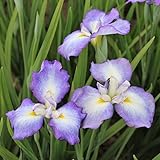 | Japanese Iris Picotee Wonder - 1 Plant - 3-4 Fan Bare Root Plant | Ships from Easy to Grow TM | Prime | Check Price on Amazon | |
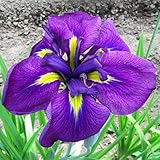 | Japanese Iris Royal Robes - 1 Plant - 3-4 Fan Bare Root Plant | Ships from Easy to Grow TM | Prime | Check Price on Amazon | |
 | (5) Blue Magic Dutch Iris Bulbs | Prime | Check Price on Amazon | |
 | Hero Series Blue Pink Louisiana Iris Honoring The Fallen Live Plant Water, Shade, Bog Garden Starter Size 4 Inch Pot Emeralds R | Prime | Check Price on Amazon | |
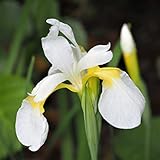 | White Japanese Iris Mt Fuji - 1 Plant - 3-4 Fan Bare Root Plant | Ships from Easy to Grow TM | Prime | Check Price on Amazon | |
 | Mixed Tall Dutch Iris - 25 Bulbs | Prime | Check Price on Amazon | |
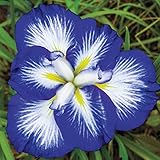 | Gusto Japanese Iris Dormant Bare Root Perennial Plant, 1-Pack | Prime | Check Price on Amazon |
Find the Ideal Setting for a Japanese Iris
When growing any plant, you need to begin by understanding the setting in which it will thrive. Here are the conditions that make for the ideal setting for a Japanese iris:
- Climate: Japanese irises are relatively cold-hardy and will survive in zones four through nine.
- Sunlight: Full sun is often best for Japanese irises. However, partial shade will work well and is often preferable in warmer climates.
- Soil: Since Japanese iris plants grow naturally in bog settings, they can often tolerate wet soil compared to other iris varieties, which is why we sometimes call it Japanese water iris. Still, the soil should be loose enough to prevent compaction. Japanese irises also do best in slightly acidic soil where the soil pH level is between five and six.
If you meet those requirements, you can grow your Japanese iris in the ground or in a container. But there remains much more to learn about before you can begin the planting process.
Time Your Japanese Iris Planting for Fall
The best time to plant a Japanese iris is during the fall months. Planting in fall will result in spectacular iris blooms in the late spring and early summer.
But while fall is the ideal time to plant a new iris, you can be a bit more flexible if you want to transplant an existing Japanese iris. Transplanting for this plant is an option during the spring and fall or any other time the weather is not excessively hot or cold. If the temperature is moderate and consistent and you keep constant moisture for your iris, transplanting is often an easy task.
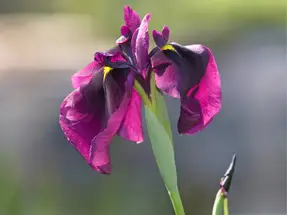
Loosen the Roots of Your Japanese Iris
Before you place your Japanese iris on the ground, you should take some time to loosen its roots. Japanese irises grow with prominent underground rhizome, out of which spread the main roots. Some novice gardeners are quick to assume the rhizome itself is a root, but that is not the case.
The true roots of your Japanese iris emerge from the bottom side of the rhizome. Separating and loosening these roots before planting encourages new root development by helping them to spread out and absorb the soil nutrients and moisture they need to support healthy growth.
Plant Your Iris at the Right Depth
Planting depth is crucial for Japanese irises. If the rhizome is too deep or shallow, the health of your plant will likely decline shortly after planting. Aim to plant your Japanese iris so that the top of the rhizome, sometimes called the crown of the plant, is at or just below the soil’s surface.
When you dig a planting hole that meets that ideal soil level, place the rhizome in it so that the roots are at the bottom of the hole. Then, cover the rhizome and the roots with humus-rich soil containing ample organic matter, pressing it as you fill to keep the plant stable and in place.
FURTHER READING
- Water Lily vs. Lotus – What’s the Difference?
- Choosing the Best Water Plants for Ponds
- Variegated Wax Plant Care
- How to Plant Elephant Ear Bulbs in Pots
- Exploring the Many Faces of Euonymus Plants
How to Care for a Japanese Iris
After you follow the four easy planting steps from the sections above, you’re ready to learn how to maintain your Japanese iris. As you’ll soon see, the three most important elements of Japanese iris care are watering, fertilization, and seasonal pruning. Read on to understand how to complete each of these chores correctly.
Alter Your Watering Based on the Season
Getting your watering schedule right is the most challenging aspect of caring for a Japanese iris. The difficulty of watering this plant results from its need for different quantities of moisture depending on the season.
In spring, Japanese irises need the most water. Generally, giving about two inches of water per week will do the trick.
In summer, you can give your Japanese iris a bit less water. About one inch per week should work well to keep your plant in good condition.
In winter, Japanese irises become intolerant of moist conditions. As such, you should ensure that you provide minimal water in the colder months and make sure that your iris’s roots are not sitting in standing water.
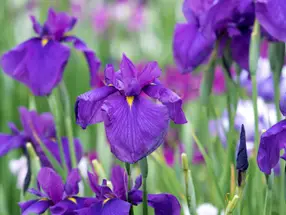
Know that Japanese Irises Are Heavy Feeders
Japanese irises need plenty of fertilizer if you want them to display the lovely blooms for which they are so well known. Supply a nitrogen-rich fertilizer in the early spring and reapply the same type of fertilizer in the early summer, just after the blooms fade.
Prune Your Japanese Iris at the Right Time
Pruning is the final key element in your Japanese iris care routine. When this plant is finished flowering, removing the spent blooms and their stalks is best. Allow the foliage to remain throughout the summer months into early autumn. Then, in the late fall before winter arrives, cut the leaves so that just a few inches remain above the soil.
Conclusion
Japanese water iris thrive in damp soil and cool water, making them a perfect choice for damp, shaded areas of the garden. They can be planted either as bare root plants or new transplants. When planting new transplants, it is important to choose a spot with ideal growing conditions. The soil should be damp but not soggy, and the plant should be placed in a shady spot. Once the plant is established, it will require very little care. Water it regularly during the growing season, and fertilize it with a water-soluble fertilizer. With proper care, Japanese water iris will provide beautiful blooms year after year.

John Haryasz is a freelance writer and landscape designer. In the field of landscape architecture, he has contributed to many successful design projects throughout the country. As a writer, John specializes in creating captivating and informative web content. Through that work, he aims to share his design knowledge and promote engagement with the outdoor world.

![How to Water Indoor Plants [Plant Care 101]](https://wraxly.com/wp-content/uploads/2021/03/How-to-Water-Indoor-Plants-Plant-Care-101-1200-1024x576.webp)

![Growing Plants from Cuttings [A Simple Guide]](https://wraxly.com/wp-content/uploads/2021/03/Growing-Plants-from-Cuttings-A-Simple-Guide-1200-1024x576.webp)